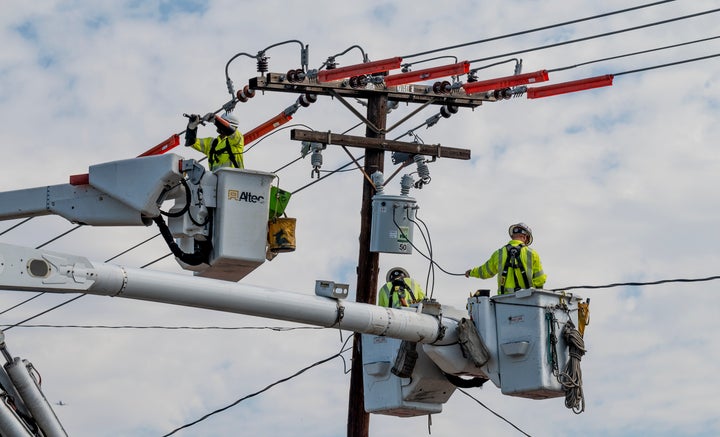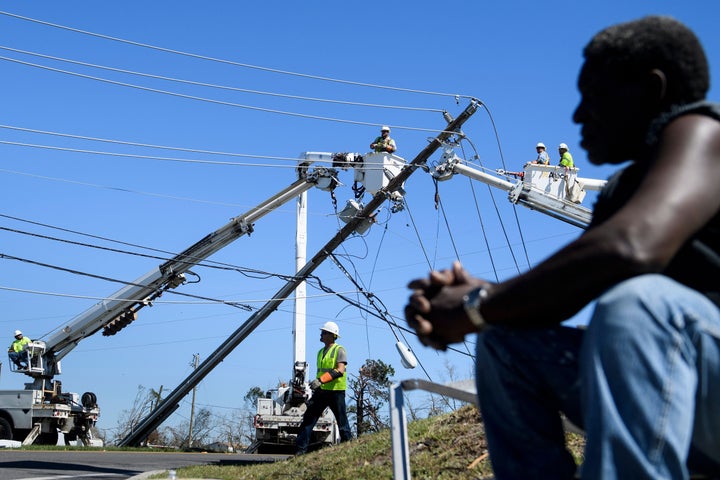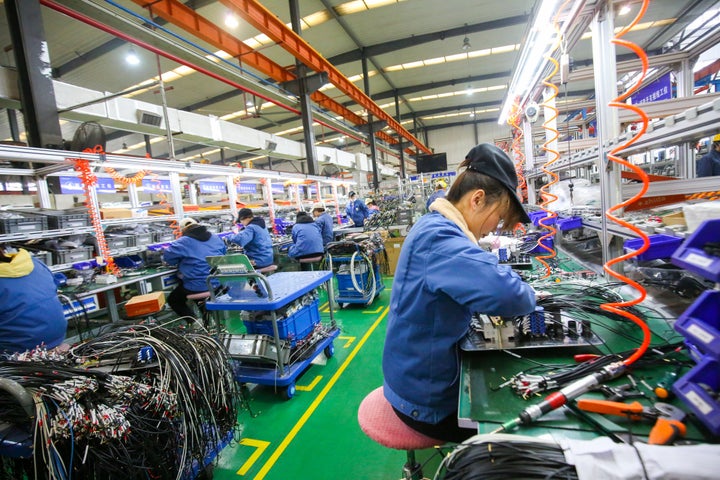
As COVID-19 ripped through the global economy in 2020, Ford stopped assembly lines at automotive factories from Michigan to Mexico. The old textile mill in the central Pennsylvania town of Sunbury that had survived the country’s last big wave of fabric plant closures shut down for good. The Texas oil fields that had made the United States a rival to Saudi Arabia in crude exports halted production.
At ERMCO Inc., a Tennessee-based manufacturer of electrical transformers, the factory floors were humming. Orders were coming in faster than ever before from the rural electric cooperatives ERMCO serves. The pandemic may have mangled many manufacturers’ supply chains, but ERMCO’s 10 facilities in states like Illinois, Indiana and Georgia kept pace with the record sales.
“In 2020, we produced more transformers than in the history of our company,” said ERMCO chief executive Tim Mills. “2021 topped that record year.”
This may only be the start of the boom, and demand may soon pick up as federal dollars from President Joe Biden’s landmark climate-spending laws begin to flow. But Mills said a new regulation meant to make transformers more energy-efficient is making it impossible to go all-in on clearing an ever-growing backlog of orders.
The resulting shortage has kept builders from completing new homes and hiked the cost of replacing power lines destroyed in storms by double or more. Transformers that once took weeks to obtain now require up to a year or more of waiting. Utilities say the crisis may be getting worse, threatening to slow the shift away from fossil fuels and increase blackouts in a country where the average household is already losing power for twice as long compared to 10 years ago.
Transformers come in hundreds of shapes and sizes, the most visible of which tend to be those housed in the metal cylinders mounted atop electrical poles. The job of large transformers in particular is to convert rivers of up to 750,000 volts into the 240-volt trickle most homes are designed to safely receive. Smaller transformers serve similar functions as electricity flows along transmission lines from power stations to substations and into homes and businesses.
Virtually every home is connected to a transformer, meaning demand for transformers historically kept pace with new housing construction.
Not anymore. Extreme storms and wildfires are destroying hundreds of transformers at a time, steadily eating into utilities’ stockpiles of the machines. That leaves even fewer to go around now that the U.S. is finally gearing up to upgrade its power grid, more than one-quarter of which was built at least half a century ago.

But it’s not just about replacing the existing grid. The U.S. needs to expand its power system to handle its two fastest-growing sources of electricity, solar and wind, which require bigger distribution networks to balance the power load when the output from panels and turbines fluctuates with the weather. If that weren’t enough, federal researchers estimate that charging cars and powering heating and cooking appliances with electricity could increase overall demand on the grid by nearly 40% over the next 27 years. All that requires more transformers.
The problem has been growing for years, and drew attention from both the Trump and Biden administrations.
“We are certainly concerned about the supply of transformers all the way across,” Energy Secretary Jennifer Granholm said at a Senate hearing last month.
Mills would like to ramp up production. But it takes years to get new assembly lines running at peak capacity, and it’s hard to bank on if the same machines he can’t produce quickly enough today might be illegal to sell in just four years.
In December, the Biden administration proposed new standards mandating that all transformers sold starting in 2027 be made with a completely different kind of steel. Environmentalists say the new rule would slash the amount of energy wasted in a transformer’s core in half compared to the current models. But manufacturers say the overall energy savings on the grid would be minimal, and warned that forcing factories to overhaul production lines may worsen the current transformer shortage and delay the shift away from fossil fuels.
The Department of Energy has yet to unveil the final version of the regulation, which just completed a public comment period where opponents appeared to far outnumber supporters.
“If I knew definitively what direction this was going to go, I could put more chips in one basket or the other,” Mills said. “All the equipment I’m purchasing to ramp up production would go one way or the other.”
But policy experts say abandoning the regulation won’t necessarily fix a problem that could be aided through federal help hiring and training more workers and establishing a government-controlled stockpile of transformers.
‘Into 2024 And Beyond’
The United States’ patchwork of electrical grids, regulators and market designs mean trends tend to play out differently across this continent-sized country. HuffPost contacted the 10 largest electrical utilities in the U.S. and several transformer manufacturers across different sectors, reviewed public filings or interviewed officials from trade associations representing rural electric cooperatives, utilities and home builders.
Transformer orders that once took weeks can now take a year or more. Large power transformers can take more than two years. Projects are getting delayed. Prices are going up. Stockpiles needed for quickly rebuilding after natural disasters are running low.
The Tennessee Valley Authority, the only federally owned utility in the country, said the push for renewables had driven up demand for transformers, causing it to experience “longer lead times and price pressures due to the transformer supply chain challenges.”

Over the past two years, North Carolina-based Duke Energy said it and other utilities had turned down new projects, “hoping to procure enough transformers to tackle their backlog, keep current projects on track, and replenish depleted stockpiles.”
“If needs aren’t met in 2023, the current spike in demand will likely grow and move into 2024 and beyond,” Madison McDonald, a Duke Energy spokesperson, wrote in a lengthy emailed response to HuffPost’s questions.
California’s largest utility, Pacific Gas & Electric, faced a particular challenge because each of the microclimates in the company’s vast West Coast territory have different transformer needs, according to a source with knowledge of the firm’s operations who was not authorized to speak publicly.
In a statement sent after this story was published, a Pacific Gas & Electric spokesperson said the company is working with trade associations and suppliers and conducting regular reviews to determine where scarce resources should be used.
“We are seeing impacts to material availability,” the company said in a statement. “PG&E mitigates supply shortages by having multiple suppliers, and also standardizes the designs we use for our transformers—which has been in alignment with national standards for more than 20 years.”
The average price of distribution transformers may have doubled or tripled, Joy Ditto, the chief executive of the American Public Power Association, told the trade publication Utility Dive in December. But she said a small utility in Tennessee that once paid $2,400 per transformer now faces bills as high as $24,000.
Blackouts are not a theoretical risk. Americans have experienced longer blackouts over the past few years. In 2021, the average American household lost power for a combined eight hours, up from less than four hours in 2013. Excluding extreme weather events from the most recently available federal statistics, the country still spent more than two hours on average in the dark, a 12% increase from 2013 and more than double what Europeans and East Asians typically experience.
Skyrocketing Demand, But Ramping Up Production Is A Risky Bet
In 2021, ERMCO announced plans to take over a defunct Caterpillar factory near its headquarters in Dyersburg, Tennessee, and build a new 200,000-square-foot production facility to help meet growing demand.
But it’s not yet clear how much of that space Mills should devote to transformers made the current way, with what’s called “grain-oriented electrical steel.” Under the Energy Department’s new rule, transformers produced four years from now would need cores made from amorphous electrical steel, which is commonly used in electric vehicles and motors.
Utilities discovered in the 1980s that the magnetic properties of amorphous steel reduced how much energy is wasted as it travels through the transformer core by as much as a third. But transformers made with that grade of steel proved more expensive because the brittler metal made manufacturing more difficult.
Amorphous steel cost more on a per-kilogram basis, and forming cores of the metal required far more labor, sending the price up further. But the Trump administration concluded in a 2020 Commerce Department report that “the material has the potential to reduce costs in the long run for utilities over the life of the transformer due to lower core losses.” The U.S. had about 600,000 amorphous metal transformers, compared with over 1 million in China and 1.3 million in India.
“It is more economical in countries with low labor costs,” the report stated.
For years, the markets for each kind of electrical steel have looked more or less identical, each with a single domestic producer in the U.S. and a handful of overseas exporters.
But U.S. energy regulators believe demand for amorphous steel for electric vehicles is going to push steelmakers to shift production away from the grain-oriented electrical steel transformers used today. Agency officials cited discussions with steelmakers in the U.S., South Korea and Germany, which all agreed to increase production. With environmentalists now claiming that amorphous steel can cut the energy wasted in transformers’ cores in half, the Biden administration saw this as the right time to mandate a change.
“I think it’s important to continue to move toward efficiency,” Granholm said at last month’s Senate Committee on Energy and Natural Resources hearing. “But we are having conversations with industry.”
Mills took part in some of those conversations. At public comment sessions for the new federal rule over the past few months, he said he encountered few if any supporters of the regulation within the industry.
“Is this the right time to throw another disruption into what’s already a very strained supply situation for increased demand for transformers for what you’re gaining in efficiency? I’d say it’s pretty clearly no.”
- Jim Matheson, CEO of the National Rural Electric Cooperative Association
Jim Matheson, chief executive of the National Rural Electric Cooperative Association, said it’s an issue of timing.
“Is this the right time to throw another disruption into what’s already a very strained supply situation for increased demand for transformers for what you’re gaining in efficiency? I’d say it’s pretty clearly no,” he said in an interview over Zoom. “If there’s a long-term value in increasing efficiency, there’s a time to talk about the right timing to do that. This is not the right time.”
Maximal efficiency gains from the amorphous steel cores depend on having steady electricity — with fluctuating loads like those from renewables, the cores are less efficient, according to the National Electrical Manufacturers Association. Industry officials have repeatedly claimed that overall efficiency would improve by a paltry 0.2% as a result of the regulation.
“There’s a disagreement about how much more efficient they are,” Granholm said when Sen. Cindy Hyde-Smith (R-Miss.) cited the figure at the April 20 hearing. “We would like to see both types of steel available.”
She stressed at least twice that the rule was only a proposal, and that the Energy Department was having ongoing discussions with industry.
In the meantime, Mills said, “The No. 1 thing I’m doing is hedging.”
Other Priorities For Defense Production Act Money
Industry associations representing utilities, manufacturers and home builders are lobbying.
In October, the National Association of Home Builders sent a letter to three top Biden administration officials warning of “grave concerns” over what the construction trade group twice referred to as “severe shortages.” In particular, they pointed to places like Duval County, Florida, where a major hurricane last year gobbled up the already limited supply of transformers for contractors trying to keep up with Jacksonville’s housing boom.
“The severe shortage of transformers and other electrical components is spreading across the country and is having a deleterious effect on efforts to implement your administration’s infrastructure plan, finish construction projects, provide affordable housing, and ultimately, will imperil the national and economic security of the United States,” read the Oct. 17 letter addressed to Granholm, Commerce Secretary Gina Raimondo and U.S. Trade Representative Katherine Tai.
Last year, Democrats in Congress earmarked $250 million in President Joe Biden’s landmark Inflation Reduction Act for direct federal purchases of strategically important appliances. Authorized under an obscure Korean War-era law known as the Defense Production Act, the administration vowed last June to use the money to “accelerate domestic manufacturing” of five key technologies: solar panels, transformers and grid equipment, heat pumps, insulation, and hardware to make and use carbon-free hydrogen fuel.

As Russia’s invasion of Ukraine sent prices of heating fuel soaring and Europeans in rich countries turned to burning wood and garbage to survive the winter, the Biden administration signaled its intention to spend the entire budget on manufacturing heat pumps, which effectively replace gas- or oil-burning furnaces with what are effectively two-way air conditioners.
In a letter dated Oct. 19, two trade groups representing municipally owned and cooperative electrical utilities pleaded with Granholm to save at least some of the Defense Production Act funding for transformers, warning of an “unacceptable risk” of blackouts from “this unprecedented situation.”
“While we support long-term investment in domestic manufacturing capacity for heat pumps ... if we don’t act today, we risk being unable to recover from a storm tomorrow,” read the letter from the American Public Power Association and National Rural Electric Cooperative Association.
Exactly two weeks later, the Energy Department formally announced plans to spend the full quarter-billion-dollars on heat pumps. Nearly two months after that, the agency proposed its new efficiency standards for transformers.
In March, the Biden administration asked Congress for another $75 million to spend on Defense Production Act priorities.
When Granholm came before the Senate energy committee to make the case for the latest White House budget request, she encouraged the lawmakers “to supply more funding” to “open more manufacturing projects.”
“We have $75 million under the DPA for that,” Granholm said. “It’s not enough to get new factories up.”
Three other senators — Republican Steve Daines of Montana and Democrats Martin Heinrich of New Mexico and John Hickenlooper of Colorado — joined Hyde-Smith in pressing Granholm about the transformer shortage. But the Mississippi Republican spent her full time on the issue, and if the energy secretary would consider postponing the rule for up to two years to help ease the current crunch.
“It seems to me the White House and your department have put the cart before the horse with these new efficiency standards versus meeting current demand,” Hyde-Smith said.
“We’re in discussions,” Granholm said.
“There’s a possibility you could delay this?” Hyde-Smith asked.
“Lots of things are possible,” Granholm replied.
“Thanks for not answering me,” the senator snapped back.
Bad Trades?
A lack of federal funding is hardly the only policy frustrating transformer manufacturers.
In 2018, President Donald Trump slapped tariffs on imports of electrical steel, a move his own Commerce Department concluded in a report two years later that had “raised material costs for lamination and core manufacturers, affecting their ability to compete, because electrical steel accounts for a large percentage of the cost of these items.”
Still, the report found that the U.S. depended on imports for 35% of electrical transformers — and a whopping 80% of the large power transformers that form the grid’s backbone.
Tariffs might help manufacturers of certain kinds of electrical transformers that “may not need to be as competitive in the global market,” said William Dull, the president of Triad Magnetics, a Perris, California-based manufacturer of transformer components for electronics. But, he said, the U.S. trade representative ultimately expanded the levies to include “all the remaining types of transformers which are primarily the ‘component’ types of transformers that are installed inside an electrical or electronic device.”

Putting tariffs on components made Dull question whether the U.S. trade representative understood the market at all.
“Long story short, I don’t think tariffs on raw materials/component parts is a good idea if we want to help USA manufacturing,” he wrote in an email. “Unfortunately, I don’t think the USTR can tell the difference between a component part and an end-product.”
He said several companies had moved their manufacturing to Mexico and South America so they could avoid the trade restrictions.
A spokesperson for Tai, the current U.S. trade representative, did not respond to emails requesting comment.
It wouldn’t be the first time U.S. trade policy threatened the American manufacturing revival on which Biden hopes to campaign for a second term.
Just weeks into his presidency, the U.S. International Trade Commission banned one of the world’s biggest electric vehicle battery manufacturers from selling its cells in the U.S. for 10 years as punishment for stealing trade secrets from its fellow South Korean rival, LG Energy Solution. The decision made it impossible for Seoul-based SK Innovation to build a $2.6 billion factory in rural Georgia.
In a reversal of usual partisan battle lines on green industrial projects, the Georgia GOP begged Biden to use a rare presidential veto to cancel the trade court ruling. The White House ultimately avoided a test of whether climate goals should trump intellectual property disputes, a question that continues to loom over U.S. efforts to persuade developing countries that avoiding mass death in a hotter, disease-ridden world will be easier without coal plants. Hours before the legal window to do so expired, the two companies reached a settlement that saved the Georgia factory.
Had SK Innovation abandoned its U.S. expansion, the historic government spending the Biden administration won in the Inflation Reduction Act the following year might have given enough incentive for companies to open additional battery factories anyway. Perhaps counterintuitively, keeping the lights on across the U.S. could prove trickier.
The Federal Energy Regulatory Commission proposed a new rule in January that would make it easier for the federal government to site new transmission lines, cutting past the state and local permitting processes that have so often given not-in-my-backyard types control over infrastructure officials say the nation needs. But the regulation is not yet in effect.
Meanwhile, utilities are shutting down the coal and nuclear power plants around which the grid was built and replacing the generation with natural gas and renewables, which produce more erratic electricity that requires more transmission capacity to balance out. The failure to build new power lines put the American heartland at risk of rolling blackouts last summer.
The tools to ease the problems all come with tradeoffs. Technology to automatically siphon energy from parked electric vehicles or reduce power consumption when demand surges can help manage the grid has stoked concerns over privacy and cyberattacks due to the near-constant need for real-time monitoring of individual households’ electricity use.
Zero-carbon sources of steady, 24/7 generation, meanwhile, are controversial to build. Hydroelectric dams destroy entire ecosystems by flooding valleys. Nuclear reactors currently take billions of dollars to construct, and face opposition from those who misunderstand radiation risks or associate fission energy with atomic weapons. Geothermal plants that harness heat from the planet’s molten core remain limited to seismic hot zones.
But none of it matters if there aren’t enough transformers to steadily deliver electricity regardless of how it’s being generated, said Matheson, who served as a Democratic congressman from Utah before joining the rural electric coop’s leading trade association. When he first started hearing complaints about shortages in late 2021, they were coming from high-growth areas outside Atlanta and other parts of the South. Now it’s from all over, and it’s more than just “the price going up and lead times getting extended out.”
“It used to be you’d order one and get it in 70 days. Then it suddenly went up to 350 days, a fivefold increase,” Matheson said. “That’s when we said, ‘Uh-oh, somehow the system isn’t keeping up.’”
Since amorphous steel can cost more and be tougher to work with, the federal government could provide funding to make up the difference for manufacturers and pay for training, according to a report published earlier this year by the Niskanen Center, a Washington-based think tank that promotes moderate policy solutions to both parties. Another solution would be to develop programs at the Department of Energy and Department of Homeland Security to stockpile transformers that could be released during shortages to keep the price down, like how the federal government sold off part of the Strategic Petroleum Reserve when oil prices soared.
“We’re going to have a rapidly expanding grid, ideally, for years into the future,” said Johan Cavert, a transmission policy analyst at the Niskanen Center who authored the January report. “So we need a longer-term strategy.”
But the short-term bottleneck needs a fix, Matheson said. An influx of new heat pumps, for example, would make “a pretty significant impact” on emissions, far more, he surmised, than improving the efficiency of transformers.
“But that means making sure there’s distribution transformers out there so those heat pumps actually work,” Matheson said. “Let’s remember the bigger picture. At the end of the day, the consumer wants to have them work and heat their homes.”
This story was updated to include a statement from PG&E.

